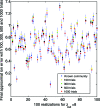Optimal partition and effective dynamics of complex networks
- PMID: 18303119
- PMCID: PMC2786939
- DOI: 10.1073/pnas.0707563105
Optimal partition and effective dynamics of complex networks
Abstract
Given a large and complex network, we would like to find the best partition of this network into a small number of clusters. This question has been addressed in many different ways. Here we propose a strategy along the lines of optimal prediction for the Markov chains associated with the dynamics on these networks. We develop the necessary ingredients for such an optimal partition strategy, and we compare our strategy with the previous ones. We show that when the Markov chain is lumpable, we recover the partition with respect to which the chain is lumpable. We also discuss the case of well-clustered networks. Finally, we illustrate our strategy on several examples.
Conflict of interest statement
The author declares no conflict of interest.
Figures



Similar articles
-
Finding and testing network communities by lumped Markov chains.PLoS One. 2011;6(11):e27028. doi: 10.1371/journal.pone.0027028. Epub 2011 Nov 3. PLoS One. 2011. PMID: 22073245 Free PMC article.
-
Probabilistic framework for network partition.Phys Rev E Stat Nonlin Soft Matter Phys. 2009 Aug;80(2 Pt 2):026106. doi: 10.1103/PhysRevE.80.026106. Epub 2009 Aug 7. Phys Rev E Stat Nonlin Soft Matter Phys. 2009. PMID: 19792199
-
Uncovering and testing the fuzzy clusters based on lumped Markov chain in complex network.PLoS One. 2013 Dec 31;8(12):e82964. doi: 10.1371/journal.pone.0082964. eCollection 2013. PLoS One. 2013. PMID: 24391729 Free PMC article.
-
Lumping evolutionary game dynamics on networks.J Theor Biol. 2016 Oct 21;407:328-338. doi: 10.1016/j.jtbi.2016.07.037. Epub 2016 Jul 27. J Theor Biol. 2016. PMID: 27475842
-
Eco-evolutionary dynamics in a disturbed world: implications for the maintenance of ecological networks.F1000Res. 2019 Jan 24;8:F1000 Faculty Rev-97. doi: 10.12688/f1000research.15629.1. eCollection 2019. F1000Res. 2019. PMID: 30728953 Free PMC article. Review.
Cited by
-
Exploring chromatin hierarchical organization via Markov State Modelling.PLoS Comput Biol. 2018 Dec 31;14(12):e1006686. doi: 10.1371/journal.pcbi.1006686. eCollection 2018 Dec. PLoS Comput Biol. 2018. PMID: 30596637 Free PMC article.
-
Finding and testing network communities by lumped Markov chains.PLoS One. 2011;6(11):e27028. doi: 10.1371/journal.pone.0027028. Epub 2011 Nov 3. PLoS One. 2011. PMID: 22073245 Free PMC article.
-
Spatial transition tensor of single cells.Nat Methods. 2024 Jun;21(6):1053-1062. doi: 10.1038/s41592-024-02266-x. Epub 2024 May 16. Nat Methods. 2024. PMID: 38755322 Free PMC article.
-
Attractor concretion as a mechanism for the formation of context representations.Neuroimage. 2010 Sep;52(3):833-47. doi: 10.1016/j.neuroimage.2010.01.047. Epub 2010 Jan 25. Neuroimage. 2010. PMID: 20100580 Free PMC article.
-
Topology of molecular interaction networks.BMC Syst Biol. 2013 Sep 16;7:90. doi: 10.1186/1752-0509-7-90. BMC Syst Biol. 2013. PMID: 24041013 Free PMC article. Review.
References
-
- Barabási AL, Albert R. Rev Mod Phys. 2002;74:47–97.
-
- Newman MEJ, Barabási AL, Watts DJ. The Structure and Dynamics of Networks. Princeton: Princeton University; 2005.
-
- National Research Council. Network Science. Washington, DC: Natl Acad Press; 2005.
-
- Shi J, Malik J. IEEE Trans Pattern Anal Mach Intell. 2000;22:888–905.
-
- Shi J, Meilā M. Appl Comput Harmon Anal; Proceedings of the Eighth International Workshop on Artificial Intelligence and Statistics; San Francisco: Kaufmann; 2001. pp. 92–97.
Publication types
LinkOut - more resources
Full Text Sources

